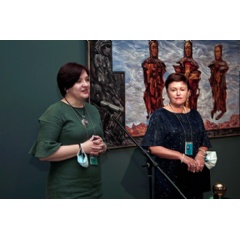Opening of the exhibition “Catherine the Great’s Romance with Stone. Glyptic Art from the Collection of the State Hermitage” in Vladivostok
Hermitage Days in Vladivostok 2020
On 25 September 2020, during the Hermitage Days in Vladivostok, the exhibition “Catherine the Great’s Romance with Stone. Glyptic Art from the Collection of the State Hermitage” opened at the Primorye (Maritime) State Picture Gallery.
Participating in the opening ceremony were Alena Datsenko, Director of the Primorye State Picture Gallery; Natalya Levdanskaya, the Gallery’s Deputy Director for Research; Alexei Bogdanov, Deputy General Director of the State Hermitage; and Yelena Arsentyeva, the exhibition curator, a researcher in the State Hermitage’s Department of Classical Antiquity.
“The objects that you will see today are unique works of art, amazing things that were made from precious materials, that have historical and artistic value. Each piece is a work of art that you want to view long and deep, that captivates you. When you look at these exhibits, you can understand why Catherine II ‘fell ill’ with cameos,” Alena Datsenko said. “We are very pleased that this project has come to fruition. After all, in the state we have been living in recently, there is a great deal of instability, a great deal of unpredictability. Museums are undoubtedly suffering from that too. The exhibition that by tradition should have opened on the Gallery’s birthday is opening during the Hermitage Days, and we are happy that everything has come together successfully. I thank the Hermitage for the support that we feel constantly.”
“You are the first place this year where we are holding Hermitage Days and opening an exhibition. The pandemic has, of course, left its mark on things, but we have striven to do all we can, and even more, to ensure everything came off. That is why we are very pleased that this is happening in Vladivostok,” Alexei Bogdanov continued. “The Hermitage’s attitude can be expressed in this way: we will be with you all the time; we will do with you what you consider necessary and important for museum affairs to advance here.”
The Hermitage’s collection of glyptic art (cameos and intaglios) is one of the largest in the world. It surpasses those of many famous museums and is on a par with the very best for the quality and quantity of the works representing the art of carving precious and semiprecious minerals.
The exhibition in Vladivostok features 30 engraved stones that give an idea of the history of collecting and the development of the stone-engraver’s art from the Archaic era of Ancient Greece to the Modern Era in Western Europe and Russia. They are all connected to one degree or another with Empress Catherine II.
The founder of the Hermitage is known for her acquisitions of paintings and sculpture, but it was carved gemstones that were her real passion. The Empress took a persistently dogged interest in multicoloured carved stones – known at the time as antiki (“antiquities”), irrespective of when they were made. It was glyptic art that fascinated Catherine II most of all, becoming by her own admission “gluttony” and “a disease as contagious as scabies”.
After beginning to collect carved stones with the purchase of the estate of the celebrated German practitioner of the art Lorenz Natter for her son, the future Paul I, the monarch continued to actively enlarge her store of cameos and intaglios. With the assistance of agents and brokers, antiquaries, artists and Russian diplomats, Catherine bought up all the more or less significant collections of carved stones that came on the art market in Italy, Britain and France. As a result, by the end of the 18th century the museum was augmented with exhibits that had once belonged to some of the noblest families in Europe.
Catherine was indeed entirely in the grip of her passion for collecting carved stones. Over the course of her reign, the Empress developed from an ordinary admirer of such gemstones into an expert and the owner of a collection of 10,000 items. The flow of glyptic art into the Winter Palace did not cease with Catherine’s passing: the collection grew through gifts and legacies, purchases, archaeological finds and other sources.
Thanks to their hardness and durability, gemstones long outlived their original owners. The beauty of a coloured mineral in combination with the virtuoso skill behind the engraved images produced an interest in glyptic art down through the centuries. Just as various exotic objects and curiosities (seashells, ostrich eggs, bezoars) were given additional decoration and expensive settings, carved stones, too, were mounted in various ways in keeping with fashion and a client’s wishes. Often they were incorporated into brooches, tiepins, rings, bracelets, necklaces or other pieces of jewellery that may not even have been intended to be worn but existed only for convenient keeping or display.
The exhibition at the Primorye State Picture Gallery in Vladivostok will run until 17 January 2021.
( Press Release Image: https://photos.webwire.com/prmedia/6/264636/264636-1.jpg )
WebWireID264636
This news content was configured by WebWire editorial staff. Linking is permitted.
News Release Distribution and Press Release Distribution Services Provided by WebWire.
